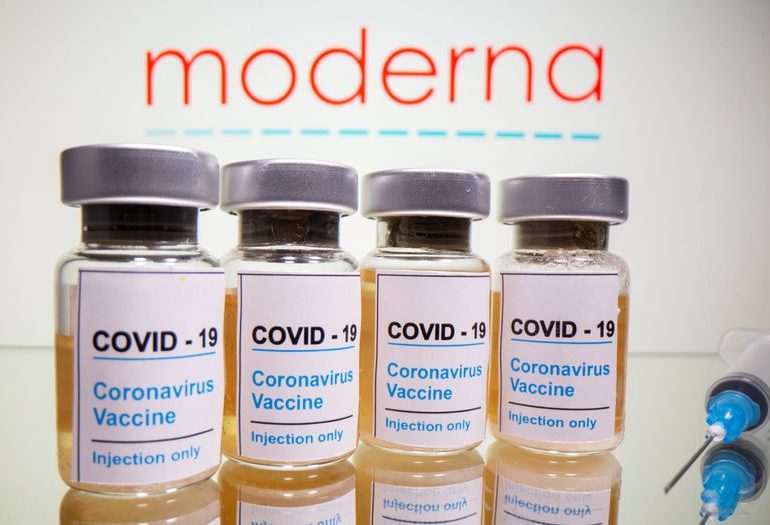2/2  © Reuters. FILE PHOTO: FILE PHOTO: Vials and medical syringe are seen in front of Moderna logo in this illustration 2/2
© Reuters. FILE PHOTO: FILE PHOTO: Vials and medical syringe are seen in front of Moderna logo in this illustration 2/2
By Julie Steenhuysen and Michael Erman
(Reuters) – Moderna (NASDAQ:MRNA) Inc will apply for U.S. and European emergency authorization for its COVID-19 vaccine on Monday after full results from a late-stage study showed it was 94.1% effective with no serious safety concerns, the company said.
Moderna also reported that the vaccine's efficacy rate was consistent across age, race, ethnicity and gender demographics as well as having a 100% success rate in preventing severe cases of a disease that has killed nearly 1.5 million people.
The filing sets Moderna's product up to be the second vaccine likely to receive U.S. emergency use authorization this year following a shot developed by Pfizer (NYSE:PFE) and BioNTech which had a 95% efficacy rate in trials.
"We believe that we have a vaccine that is very highly efficacious. We now have the data to prove it," Moderna Chief Medical Officer Tal Zaks said. "We expect to be playing a major part in turning around this pandemic."
Of the 196 volunteers who contracted COVID-19 in the trial with more than 30,000 people, 185 received a placebo while 11 got the vaccine. Moderna reported 30 severe cases – all in the placebo group – which means the vaccine was 100% effective in preventing severe cases.
"As the numbers of cases reported grows, confidence grows that this amazing protection will be maintained in a product that can be rolled out to protect the public," said Alexander Edwards, associate professor in biomedical technology at Britain's University of Reading.
In addition to filing its U.S. application, Moderna said it would seek conditional approval from the European Medicines Agency, which has already begun a rolling review of its data, and would continue to talk with other regulators.
Pfizer has already applied for emergency use authorization in the United States and Europe, putting it about a week ahead of Moderna.
Moderna said it was on track to have about 20 million doses of its vaccine ready to ship in the United States by the end of 2020, enough to inoculate 10 million people.
'JUST OVERWHELMING'
Both of the vaccines use a new technology called synthetic messenger RNA (mRNA) whereas others, such as Britain's AstraZeneca (NASDAQ:AZN), are using more traditional methods to develop their vaccines.
AstraZeneca has announced an average efficacy rate of 70% for its shot and as much as 90% for a subgroup of trial participants who got a half dose, followed by a full dose. But some scientists have expressed doubts about the robustness of the 90% efficacy figure for the smaller group.
Moderna's latest efficacy result is slightly lower than an interim analysis released on Nov. 16 of 94.5% effectiveness, a difference that Zaks said was not statistically significant.
"At this level of effectiveness, when you just do the math of what it means for the pandemic that's raging around us, it's just overwhelming," said Zaks, who said he cried when he saw the final results over the weekend.
Both the Moderna and Pfizer vaccines proved more effective than anticipated and were far superior to the 50% benchmark set by the U.S. Food and Drug Administration (FDA).
The past few weeks of positive vaccine results have ignited hopes for an end to a pandemic that has battered economies and comes as new infections and COVID-19 hospitalizations are at record levels across the United States.
Independent advisers to the FDA are scheduled to meet on Dec. 17 to review Moderna's trial data and make a recommendation to the FDA. They will meet on Dec. 10 to review Pfizer's data.
Shortly after gaining emergency use authorization, Moderna expects the vaccine to be shipped to distribution points throughout the United States by the government's Operation Warp Speed program and McKesson Corp (NYSE:MCK), a drug distributor contracted by the U.S. government.
Its distribution is expected to be easier than Pfizer's because while it needs to be stored in a freezer, it does not require the ultra-cold temperature needed by Pfizer's vaccine.
CONSISTENT ACROSS AGE AND ETHNICITY
Moderna said the 196 COVID-19 cases in its trial included 33 adults over 65 years old and 42 volunteers from racially diverse groups, including 29 Latinos, 6 Blacks, 4 Asian Americans and 3 multiracial participants. There was one death related to COVID-19 in the placebo group.
Azra Ghani, chair in infectious disease epidemiology at Imperial College London, said Monday's details from Moderna confirmed the vaccine was highly efficient, including against severe cases.
"Whilst this does not exclude some risk of severe disease after vaccination given the relatively small number of severe cases, these results suggest very high efficacy," she said.
Zaks said the vaccine has been developed during a period of "political acrimony" and having a highly effective vaccine may go a long way toward erasing some of that distrust.
"This is as black and white as an effect on a population will be. Your chances of actually being sick if you've been vaccinated are decreased 20-fold," he said.
Moderna reported no new side effects since its interim analysis. Based on that analysis, the most common side effects were fatigue, injection site redness and pain, headache and body aches, which rose after the second dose and were short-lived.
Zaks said the vaccine caused significant flu-like symptoms in some participants, which, he said, "goes hand-in-hand with having such a potent vaccine." But it has not caused any significant safety concerns so far.
Moderna plans to start a new trial to test the vaccine in adolescents before the end of the year, followed by another in even younger volunteers early in 2021. It hopes to have the vaccine available for adolescents by September, Zaks said.
Other vaccine makers have said they are studying their vaccines in young people as well.
Leave a comment
